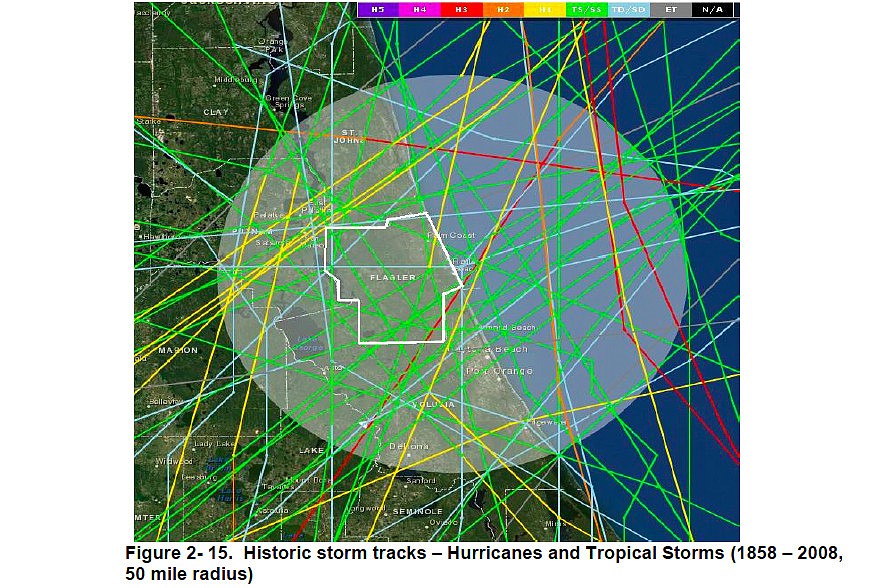- April 19, 2024
-
-
Loading

Loading

The Army Corps of Engineers’ map of northeast Florida is crisscrossed with green, yellow, orange and red lines overlaying one another like the slice marks on a cutting board — too many to count — each representing a hurricane or tropical storm that passed within 50 miles of Flagler County between 1958 and 2008.
Those frequent storms, the Corps says, are one reason renourishment is important: Right now, storm surge from any direct hit by a hurricane, even a category 1 storm, could wash over State Road A1A. Sand acts as a buffer.
Right now, the road, the sole north-south hurricane evacuation for people living on much of the barrier island, is ailing, threatened by erosion.
Communities and the state have tried to push back the sea with revetments, sea walls and breakwaters, some of them funded by the Florida Department of Transportation, which spends about $1.5 million per year maintaining a shrinking 9,000-foot-long granite revetment between Seventh Street South and 23rd Street South in Flagler Beach, according to the Army Corps report.
But the Florida Department of Transportation’s jurisdiction ends about 50 feet away from the roadway.
The Army Corps has presented a more comprhensive approach: dredging 330,000 cubic yards of sand from offshore borrow sites and pumping it onto the beach between Seventh Street and 28th Street in Flagler Beach to extend the dune seaward 10 feet.
After the initial construction, the Army Corps would return once every 11 years or so and add another 330,000 cubic yards of sand. Over 50 years, according to the Army Corps report, the project would cost about $43,465,000, of which $23,852,050 would be paid by the federal government. The Flagler County-area infrastructure threatened by erosion, including A1A, is worth about $340 million, according to the Army Corps report.
The plan hasn’t gotten rave reviews from local government officials, many of whom have called it less than ideal but better than nothing.
Flagler Beach commissioners, in particular, have hoped for alternatives that wouldn’t involve a Sisyphean process of continually adding sand as it’s washed away by storms and the natural processes that shape the county’s shoreline.
They’ve looked into some, including groins and “undercurrent stabilizers” designed to help trap sand along the beach.
But in its Flagler County study, the Army Corps ranked a series of potential “structural measures” to combat erosion, grading each on its impact on national economic development, regional economic development, environmental impact and other social effects.
Beach renourishment got the highest number of points, because, according to the report, it would protect the A1A evacuation route while extending the berm for recreation and likely helping the local tourism industry, and because it could be economically justified at the federal level and would be easy to adjust to sea level rise.
Of the other alternatives, undercurrent stabilizers got the lowest number, in part because they could trap hatching sea turtles and would be difficult to justify economically because they haven’t been proven to work in an environment similar to Flagler Beach.
Emergent breakwaters got low points because they could pose a navigational hazard and might look unsightly. Submerged artificial reefs were deemed a potential threat to swimmers, and not easily adaptable to rising sea levels. Groins could help protect Oceanshore Boulevard, but would only benefit a few select areas, and could be a sea turtle hazard.
The Corps has extensive experience with beach renourishment projects, including one that revitalized Miami Beach’s beachfront and tourism in the 1980s, and another along a stretch of coast in Virginia Beach that has been built up 49 times since 1951, according to an NPR report.
The U.S. Army Corps of Engineers has extended the public comment period on the plan to March 15.
To view the draft plan on the Flagler County website, visit http://www.flaglercounty.org/ArchiveCenter/ViewFile/Item/3417.
To submit comments on the plan, email [email protected].